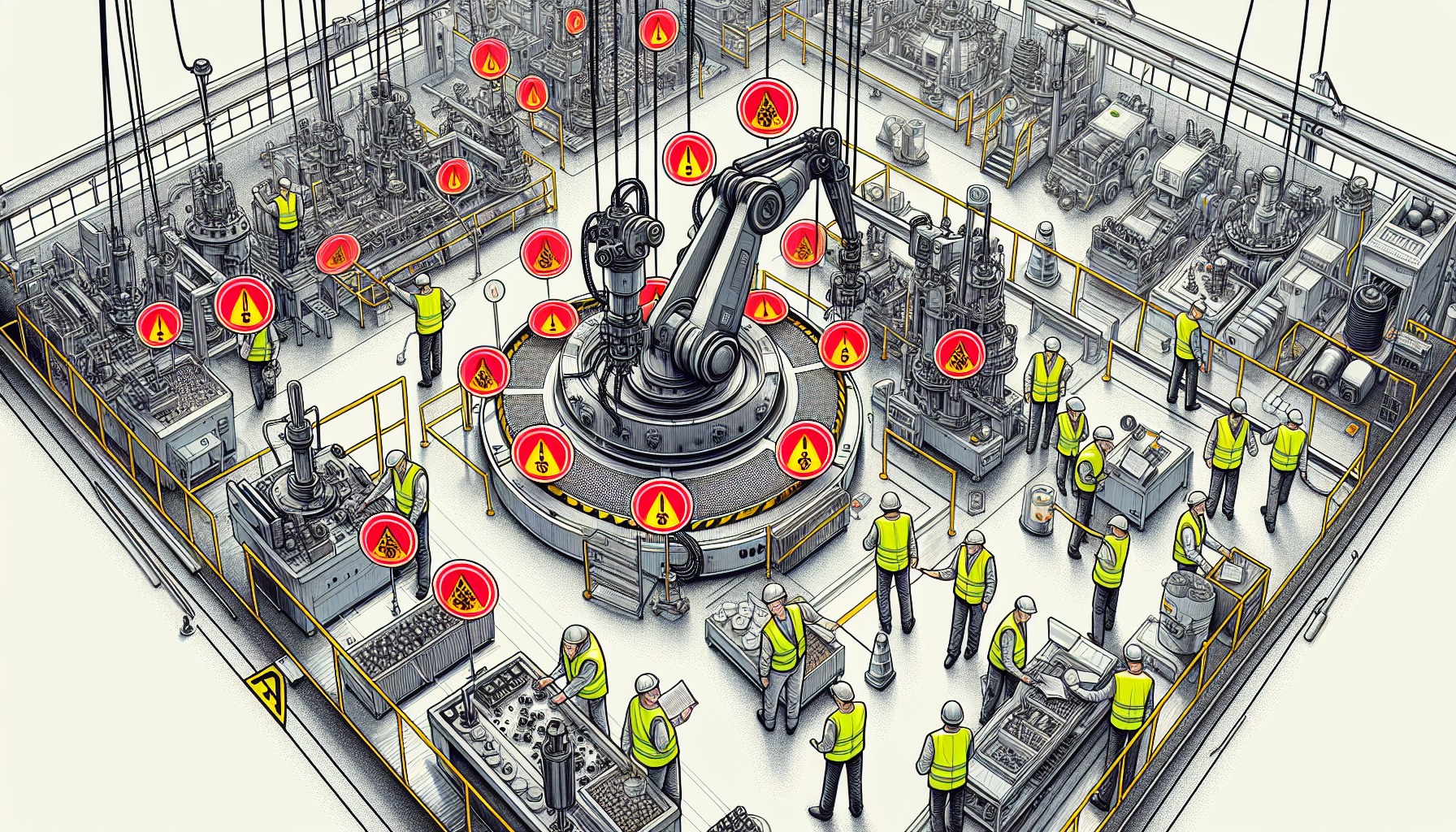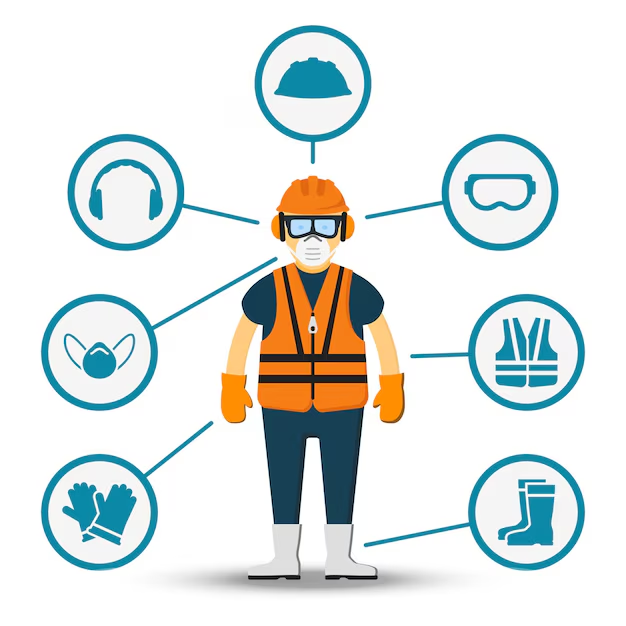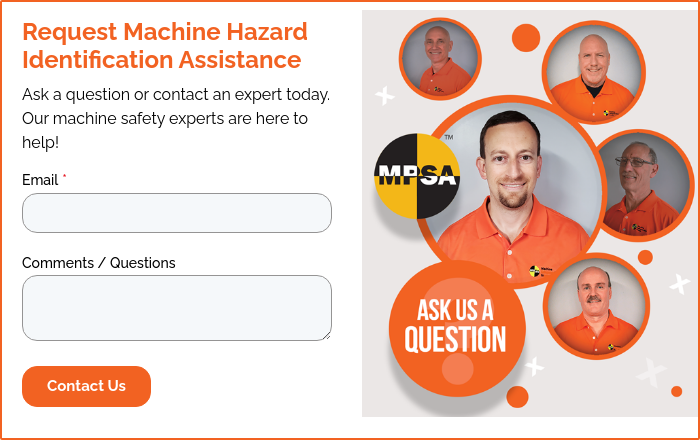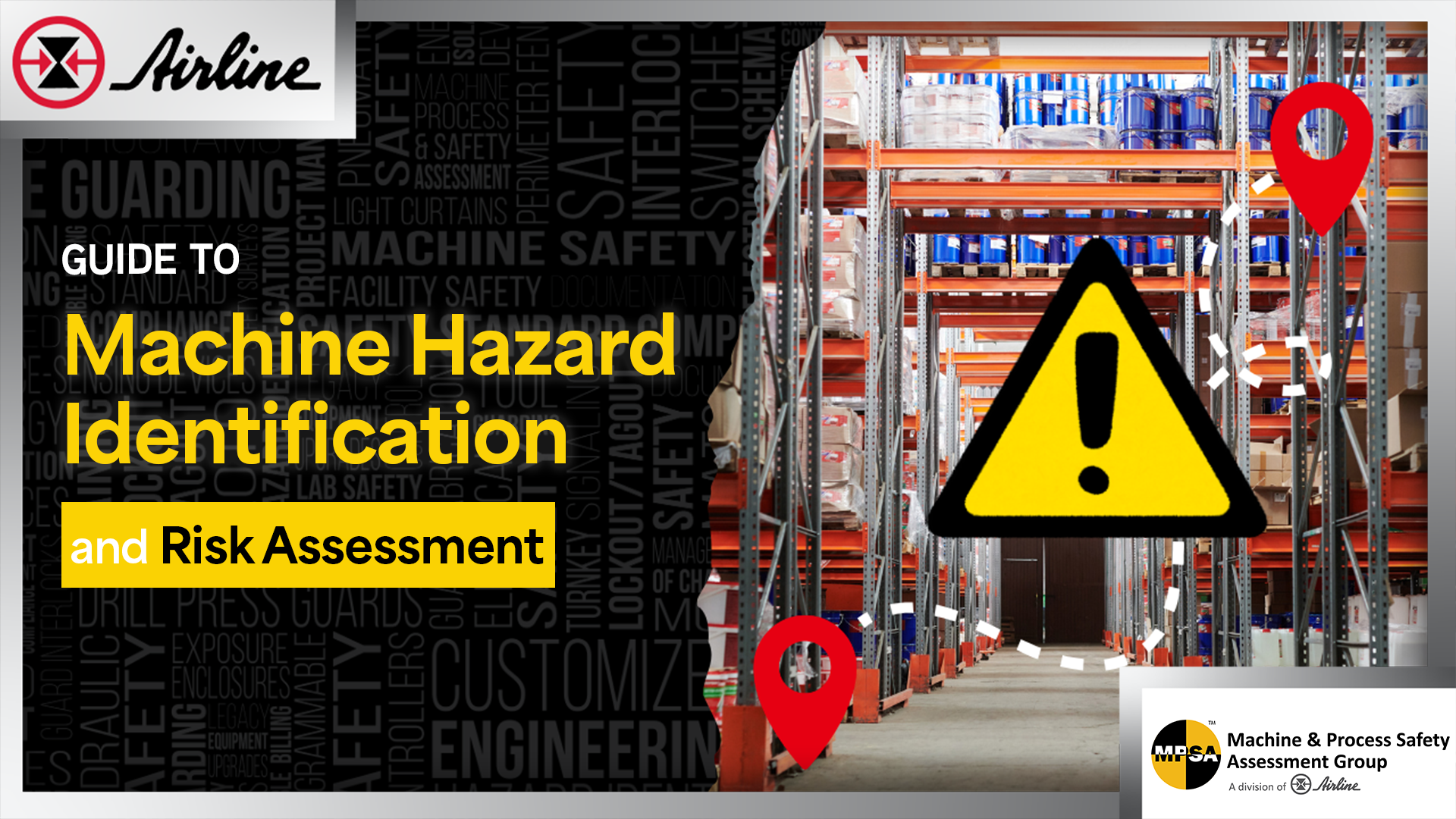What is a workplace practice that is simultaneously the most overlooked and the most essential? The answer: Machine safety. In fact, it's often the hidden, unrecognized risks that present the greatest potential for serious, if not fatal, injuries. Machine hazard identification is the structured process that involves identifying potential hazards during the operation and maintenance of industrial machinery. By identifying these hazards, businesses can implement machine safety measures to prevent accidents and protect their employees, improve productivity, and prevent business interruption. In this guide, we explore different types of machine hazards, methods to identify them, and steps to enhance machine safety.
Skip to a Section
Understanding Machine Hazards | Machine Hazard Identification | Methods for Identifying Machine Hazards | MPSA's Options | Implementing Safety Measures | Regular Maintenance and Inspections | Choosing the Right Option | Frequently Asked Questions | Additional Resources
Key Takeaways✔️ Understanding and mitigating various machine hazards, such as mechanical, electrical, hydraulic, pneumatic, inertia, chemical exposure, and thermal risks, are crucial for ensuring workplace safety. ✔️ Effective machine hazard identification enhances workplace safety, ensures regulatory compliance, and protects valuable assets through systematic approaches like visual inspections, checklists, and advanced technologies. ✔️ Implementing appropriate safety design measures, including machine guarding and safety control solutions, as well as employee training and maintenance, is essential for preventing machine-related accidents and ensuring a safe working environment. |
Understanding Machine Hazards
Understanding the different machine hazards is needed to implement effective safety measures and prevent machine safety accidents. Machinery safety includes identifying, assessing, and mitigating risks associated with mechanical equipment. These hazards can range from mechanical and electrical dangers to thermal risks and software malfunctions, each posing significant threats to worker exposure and physical safety hazards.
Mechanical Hazards
A mechanical hazard refers to any source of mechanical energy potential causing harm or injury to operators. This includes moving parts of machinery, tools, and equipment that can cause cuts, crushing, entanglement, or other physical injuries. These are common in industrial machinery and include risks such as:
- Crushing
- Cutting
- Entanglement
- Chemical hazards
Unguarded or improperly guarded machinery hazards pose a risk of catching workers’ clothing, hair, or limbs, potentially causing severe injuries, amputations, or death. Properly guarding moving parts and using safety devices like emergency stop buttons are essential in mitigating these risks. Talk to your operators, seek their input, and have them avoid loose clothing or jewelry that could get caught in machinery. This will help prevent accidents and ensure a safe working environment for operators and nearby personnel or reach out to us for machine guarding support and solutions, MPSA handles everything from design, manufacturing, installation and validation.
Electrical Hazards
Faulty wiring or equipment can lead to electrical hazards in industrial machinery, like shocks or arc flashes. Proper grounding helps reduce the risk of these dangers. Regular electrical inspections and using ground fault circuit interrupters (GFCIs) can also greatly lower the risk of shocks. Staying away from damaged or wet electrical equipment is crucial for preventing hazards, keeping the workplace safe, and reducing the chance of serious injuries.
Hydraulic and Pneumatic
Hydraulic and pneumatic machinery hazards often arise during service, maintenance, or repair, where stored energy must be recognized, secured, and then relieved to a zero energy state. This may involve installing approved safety devices to control and manage this important sequence to make machinery safe to work on.
Inertia
Refers to large or heavy machine parts or products being handed by the machine that may be released from a normal machine function or motion and be subject to movement due to the forces of gravity. This can also include springs under compression or tension. In these cases, the unwanted movement must be anticipated, and proactive devices must be installed to allow for the safe and controlled release or safe-locking of the potential hazardous forces.
Chemical Exposure
Depending upon the type of machinery being operated, there may be chemical contamination or the release of chemical materials when the machine is stopped, opened, or undergoing service, maintenance, or repair.
Thermal Hazards
Thermal hazards associated with machinery include burns and the ignition of flammable materials. These risks can arise from hot surfaces, steam, or overheating components within the machinery. Preventive measures are necessary for ensuring machinery safety from thermal hazards, including insulation to reduce heat transfer, protective barriers to keep personnel away from hot surfaces, cooling systems to maintain safe operating temperatures and proper personal protective equipment such as heat-resistant gloves and clothing. Additionally, regular maintenance and monitoring of machinery can help detect and address potential thermal hazards before they become serious issues.
The Importance of Machine Hazard Identification

Identifying machine hazards is crucial for businesses. It helps enhance workplace safety, ensures regulatory compliance, and manages risks, ultimately leading to a more productive and secure work environment.
Businesses can lower the risk of incidents and protect employees by spotting potential hazards, evaluating their likelihood and severity, and implementing the right measures. This forward-thinking approach fosters a workplace where operators feel safe, increasing employee morale and productivity.
Enhancing Workplace Safety
Recognizing machinery-related hazards is crucial for protecting everyone. Using a checklist helps ensure that everything is covered during hazard assessments by covering all necessary categories and job-specific factors.
Employers and workers should:
✔️ Collect and review information about existing and potential hazards in the workplace to make informed decisions
✔️ Investigate incidents, including near misses, to determine underlying hazards and safety program deficiencies.
To learn more about an internal hazard assessment, "Hazard Prevention and Control."
Compliance and Regulatory Requirements
Adhering to safety rules and standards in industrial manufacturing prevents legal issues and fines. Facilities must comply with regulations from bodies like OSHA and meet standards such as ISO-12100 and ANSI B11.0 to ensure legal compliance and avoid penalties. Remember, other than avoiding fines, adhering to safety rules and standards in industrial manufacturing ensures high-quality and safe products for customers. Compliance with these regulation and standards leads to reliable and trustworthy products, enhancing customer satisfaction and trust.
Risk Management and Asset Protection
Identifying potential dangers effectively helps safeguard important machinery and assets by using appropriate safety precautions. Assessing how severe and likely these hazards are helps determine which corrective actions should be prioritized. This proactive approach ensures that those presenting the greatest risk are addressed first, safeguarding personnel and machinery.
Methods for Identifying Machine Hazards
![]() Machine hazards can be identified using various methods; let's quickly review some of the most common methods for identifying machine hazards:
Machine hazards can be identified using various methods; let's quickly review some of the most common methods for identifying machine hazards:
Visual Inspections
Regular safety inspections can help spot potential hazards and help ensure equipment is safe. These checks can reveal new or emerging dangers that might have been missed initially. Documenting inspections with photos or videos and interviewing operators helps with later discussions and planning control measures.
Visual inspections should include the following steps:
✔️ Assess the machinery for signs of damage, wear, or irregularities.
✔️ Inspect safety guards, emergency stop buttons, and warning signs for integrity and proper functioning.
✔️ Check for physical hazards such as wear and tear, loose components, and malfunctioning safety guards.
These steps will help detect and address potential issues during the visual inspection.
Checklists and Audits
A systematic approach to hazard identification and consistent evaluation can be achieved via checklists and audits. A hazard identification checklist is a structured approach to document and examine workplace hazards systematically. Detailed checklists help systematically identify hidden hazards and ensure that no part of the equipment is missed during inspections.
Common dangers fall into several main categories, which may vary by workplace, including:
- General housekeeping
- Slip, trip, and fall risks
- Electrical dangers
- Equipment usage
- Equipment upkeep
- Fire safety
- Work organization and process flow (including staffing and scheduling)
- Work practices
- Workplace violence
- Ergonomic issues
- Absence of emergency procedures
Advanced Technologies
Advanced technologies like sensors and predictive AI programs can enhance the accuracy and efficiency of hazard identification. Sensors can detect irregularities in machine operations, indicating potential hazards, while AI-based systems can analyze machine data to predict and identify hazards before they manifest. These technologies significantly improve the safety and efficiency of operations.
MPSA's Machine Hazard Identification Options
MPSA offers tailored machine hazard identification options, including a Machine Safety Survey, a Machine Safety Risk Assessment, and a Machine Safety Risk Assessment and detailed scope. MPSA has designed each option to address specific needs based on the safety journey stage, the scope of safety needs, tolerance for disruption, and the safety assessment budget. Each option is tailored to cater to different requirements depending on these factors. Learn more in out blog post, "Understanding Machine Hazard Identification: Which Option is Right for Your Needs?"
Machine Safety Survey 💲
The Machine Safety Survey is a quick and efficient way to identify machine safety risks. Here are some key features of the survey:
- Requires approximately one hour per machine for analysis
- Survey results are presented in an Excel file
- Details of findings and risks, along with corrective actions and budgetary cost estimates
- Ideal for businesses seeking a rapid assessment without significant disruption.
Learn More: Safety Survey
Machine Safety Risk Assessment 💲💲
The Machine Safety Risk Assessment offers a detailed evaluation of machine hazards and is useful for meeting mandatory risk assessment requirements. This process typically requires one day for the assessment and an additional day for implementing controls and conducting mechanical reverse engineering. It is particularly important for new machine designs or significant upgrades.
Learn More: Safety Risk Assessment
Machine Safety Risk Assessment with a Detailed Scope 💲💲💲
The Machine Safety Risk Assessment with a Detailed Scope provides a comprehensive solution with a full machine safety evaluation, ensuring a safe working environment. It includes a detailed description and pricing of all necessary safety control solutions identified in the evaluation, along with plan-view conceptual mechanical layout drawings in PDF format.
Learn More: Risk Assessment with a Detailed Scope
Implementing Safety Measures
Preventing accidents and injuries relies on implementing occupational safety measures such as machine guarding techniques and personal protective equipment (PPE). These measures ensure a safe working environment and minimize downtime due to accidents, thereby improving productivity. Let's review.
Machine Guarding Techniques
Machine guarding techniques, including fixed guards and interlocking guards, provide effective barriers against mechanical hazards. Fixed guards are a permanent part of the machine, offering a simple and effective barrier. Interlocking guards prevent the machine from starting if the guard is open, enhancing safety. These techniques are essential for protecting workers from mechanical hazards.
Adjustable guards allow flexibility for various material sizes while protecting the point of operation. Self-adjusting guards provide an opening only large enough for the material when moved into the danger area. When fixed guards are impractical, trip systems such as photoelectric devices and pressure-sensitive mats can be used.
Shop Machine Safety Components
Personal Protective Equipment
Personal protective equipment (PPE), such as safety glasses and hearing protection, should be used in conjunction with other safety measures. Appropriate protective clothing, such as safety glasses, hearing protection, and safety shoes, is essential when operating machines. Prolonged exposure to high decibel levels can lead to irreversible hearing damage.
Adding sound-dampening materials to machinery design helps reduce noise levels, while providing PPE like earmuffs or earplugs can protect against hearing damage. Both measures are effective in lowering the risk of hearing damage. These measures are vital for ensuring workplace safety and protecting workers from physical safety hazards.

Regular Maintenance and Inspections
Regular maintenance and inspections are necessary for ongoing machine safety and hazard prevention. Conducting regular maintenance tasks at intervals can help prevent major machine breakdowns, reduce downtime, and increase productivity. These practices are not just regulatory requirements but crucial for workplace safety management.
Conducting Regular Inspections
Regular inspections ensure machinery compliance with safety standards and reveal new or recurring hazards. They involve checking machinery for potential safety issues and ensuring it meets safety standards. Documenting findings during visual inspections is crucial for traceability and accountability.
Workers' input, including surveys and safety committee meetings, can provide valuable insights into workplace hazards. This collaborative approach ensures that all potential hazards are identified and addressed effectively.
Scheduled Maintenance Programs
Scheduled maintenance programs can prevent serious malfunctions and reduce downtime by detecting wear and tear early. These programs involve setting inspection dates based on the type of equipment to ensure everything is checked regularly.
Effective hazard identification can prolong machinery's lifespan and reduce repair costs. Learn more about different maintenance strategies in our blog post, "Maintenance Strategies Explained | Reactive, Preventive & Predictive Maintenance."
Choosing the Right Hazard Identification Option
.png?width=117&height=117&name=3409420%20(1).png) The selection of the right hazard identification option is contingent upon specific requirements, including safety needs, acceptable level of disruption, and budget constraints. Each MPSA option is designed to cater to these specific needs, ensuring that businesses can select the most appropriate solution for their operations. Learn more in out blog post, "Understanding Machine Hazard Identification: Which Option is Right for Your Needs?"
The selection of the right hazard identification option is contingent upon specific requirements, including safety needs, acceptable level of disruption, and budget constraints. Each MPSA option is designed to cater to these specific needs, ensuring that businesses can select the most appropriate solution for their operations. Learn more in out blog post, "Understanding Machine Hazard Identification: Which Option is Right for Your Needs?"
Assessing Specific Needs
Determining the best hazard identification option requires a crucial assessment of specific needs, considering factors like the scope of safety needs, tolerable level of disruption, and budget constraints.
The Machine Safety Risk Assessment provides a detailed evaluation of machine hazards, indicating a more extensive scope of safety needs. Budget constraints also play a significant role in selecting a hazard identification option.
Making an Informed Decision
A key step involves making an informed decision based on both internal and external sources of hazard information. Some important considerations include:
- Conducting a thorough risk assessment to identify potential hazards
- Gathering information from industry experts, safety organizations, and government agencies
- Consulting with employees and other stakeholders to gather their insights and experiences
- Reviewing incident reports and near-miss incidents to identify common hazards
- Keeping up-to-date with industry standards and regulations
By considering these sources of information, businesses can make a well-informed decision when selecting a hazard identification option. MPSA, Airline's machine safety brand, offers solutions like the Machine Safety Survey and Risk Assessments to address various safety needs. By assessing needs and making informed decisions, businesses can achieve a safer, more compliant, and more productive environment.











Leave Comment